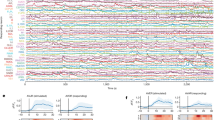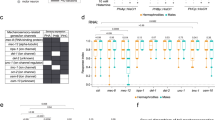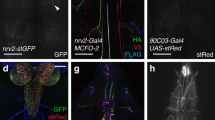Abstract
NEURONAL signalling across synapses involves activation of many neurotransmitter receptors on postsynaptic cells, glr-1 encodes a potential glutamate receptor in the nematode Caenorhabditis elegans which is most similar to vertebrate AMPA-type ionotropic glutamate receptors1, glr-1 is expressed in motor neurons and inter-neurons, including interneurons implicated in the control of locomotion2. Here we investigate the contribution of glr-1 to the normal signalling of these neurons, by generating a deletion mutation in glr-1. We find that mutant worms are deficient in their ability to withdraw backwards when mechanically stimulated, but they withdraw normally in response to chemical repellents. The ASH sensory neurons mediate withdrawal responses both to mechanical stimuli and to chemical repellents3,4, and ASH makes chemical synapses with glr-1-expressing interneurons. Our results suggest that postsynaptic interneurons use different neurotransmitter receptors to process two sensory stimuli detected by one sensory neuron.
This is a preview of subscription content, access via your institution
Access options
Subscribe to this journal
Receive 51 print issues and online access
$199.00 per year
only $3.90 per issue
Buy this article
- Purchase on Springer Link
- Instant access to full article PDF
Prices may be subject to local taxes which are calculated during checkout
Similar content being viewed by others
References
Hollmann, M. & Heinemann, S. A. Rev. Neurosci. 17, 31–108 (1994).
Chalfie, M. et al. J. Neurosci. 5, 956–964 (1985).
Kaplan, J. & Horvitz, H. Proc. natn. Acad. Sci. U.S.A. 90, 2227–2231 (1993).
Bargmann, C., Thomas, J. & Horvitz, H. Cold Spring Harb. Symp. quant. Biol. 55, 529–538 (1990).
Keinanen, K. et al. Science 249, 556–560 (1990).
Boulter, J. et al. Science 249, 1033–1037 (1990).
Ultsch, A. et al. Proc. natn. Acad. Sci. U.S.A. 89, 10484–10488 (1992).
Darlison, M. G., Hutton, M. L. & Harvey, R. J. in Exs 63: Comparative Molecular Neurobiology (ed. Pichon, Y.) 48–64 (Birkhäuser, Basel, 1993).
Stern-Bach, Y. et al. Neuron 13, 1345–1357 (1994).
Chalfie, M., Tu, Y., Euskirchen, G., Ward, W. & Prasher, D. Science 263, 802–805 (1994).
Driscoll, M. & Chalfie, M. Nature 349, 588–593 (1991).
Canessa, C. M., Harisberger, J. D. & Rossier, B. C. Nature 361, 467–470 (1993).
Zwaal, R. R., Broeks, A., van Meurs, J., Groenen, J. T., & Plasterk, R. H. Proc. natn. Acad. Sci. U.S.A. 90, 7431–7435 (1993).
White, J. G., Southgate, E., Thomson, J. N. & Brenner, S. Phil. Trans. Soc. Lond. B 314, 1–340 (1986).
Chalfie, M. & Wolinsky, E. Nature 345, 410–416 (1990).
Hart, A. C., Sims, S., Kaplan, J. M. Nature, 378, 82–85 (1995).
Verrall, S. & Hall, Z. W. Cell 68, 23–31 (1992).
Culotti, J. G. & Russell, R. L. Genetics 90, 243–256 (1978).
O'Malley, D. M., Sandell, J. H. & Masland, R. H. J. Neurosci. 12, 1394–1408 (1992).
DeVries, S. H. & Baylor, D. A. Cell/Neuron 72/10 (suppl.), 139–149 (1993).
Schotland, J. et al. Nature 374, 266–268 (1995).
Church, P. J., Whim, M. D. & Lloyd, P. E. J. Neurosci. 13, 2790–800 (1993).
Bochet, P. et al. Neuron 12, 383–388 (1994).
Jonas, P., Racca, C., Sakmann, B., Seeburg, P. H. & Monyer, H. Neuron 12, 1281–1289 (1994).
Hollman, M., Maron, C. & Heinemann, S. Neuron 13, 1331–1343 (1994).
Wilson, R. et al. Nature 368, 32–38 (1994).
Barstead, R. J. & Waterston, R. H. J. biol. Chem. 264, 10177–10185 (1989).
Krause, M. & Hirsh, D. I. Cell 49, 753–761 (1987).
Devereaux, J., Haeberli, P. & Smithies, O. Nucleic Acids Res. 12, 387–395 (1984).
Altschul, S. F., Gish, W., Miller, W., Myers, E. W. & Lipman, D. J. J. molec. Biol. 215, 403–410 (1990).
Fire, A., White-Harrison, S. & Dixon, D. Gene 93, 189–198 (1990).
Author information
Authors and Affiliations
Rights and permissions
About this article
Cite this article
Maricq, A., Peckol, E., Driscoll, M. et al. Mechanosensory signalling in C. elegans mediated by the GLR-1 glutamate receptor. Nature 378, 78–81 (1995). https://doi.org/10.1038/378078a0
Received:
Accepted:
Issue Date:
DOI: https://doi.org/10.1038/378078a0
This article is cited by
-
Molecular and circuit mechanisms underlying avoidance of rapid cooling stimuli in C. elegans
Nature Communications (2024)
-
The transcription factor unc-130/FOXD3/4 contributes to the biphasic calcium response required to optimize avoidance behavior
Scientific Reports (2022)
-
Opponent vesicular transporters regulate the strength of glutamatergic neurotransmission in a C. elegans sensory circuit
Nature Communications (2021)
-
The glutaminase (CgGLS-1) mediates anti-bacterial immunity by prompting cytokine synthesis and hemocyte apoptosis in Pacific oyster Crassostrea gigas
Scientific Reports (2021)
-
Loss of egli-1, the Caenorhabditis elegans Orthologue of a Downstream Target of SMN, Leads to Abnormalities in Sensorimotor Integration
Molecular Neurobiology (2020)
Comments
By submitting a comment you agree to abide by our Terms and Community Guidelines. If you find something abusive or that does not comply with our terms or guidelines please flag it as inappropriate.



